Name Hermann, von | ||
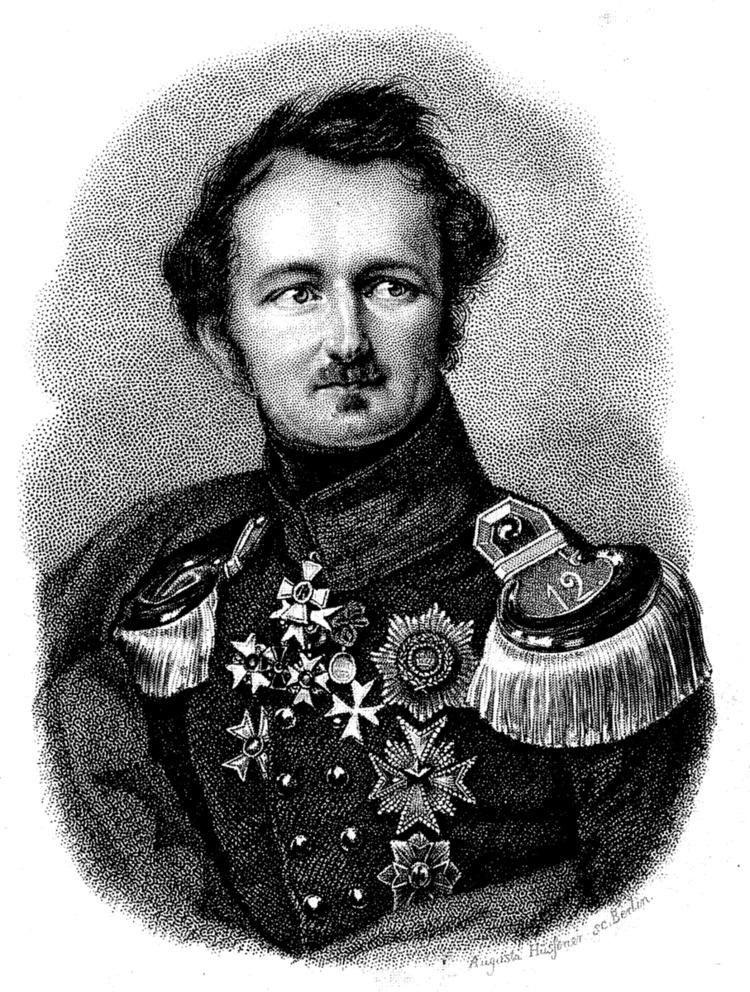 | ||
Hermann f rst von p ckler muskau
Prince Hermann Ludwig Heinrich von Pückler-Muskau ( listen ; born as Count Pückler, from 1822 Prince; 30 October 1785 – 4 February 1871) was a German nobleman, who was an excellent artist in landscape gardening and wrote widely appreciated books, mostly about his travels in Europe and Northern Africa, published under the pen name of "Semilasso".
Contents
- Hermann f rst von p ckler muskau
- Michael Apel als Hermann Frst von Pckler Muskau
- Life
- The artist
- Publications
- Frst Pckler Eis
- References
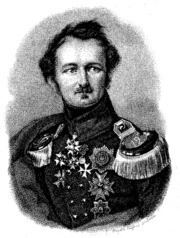
Michael Apel als Hermann Fürst von Pückler Muskau
Life
Pückler-Muskau was the first of five children of Count Carl Ludwig Hans Erdmann Pückler, and the Countess Clementine of Callenberg, who gave birth to him at age 15. He was born at Muskau Castle (now Bad Muskau) in Upper Lusatia, then ruled by the Electorate of Saxony. He served for some time in the Saxon "Garde du Corps" cavalry regiment at Dresden, and afterwards traveled through France and Italy, often by foot. In 1811, after the death of his father, he inherited the Standesherrschaft (barony) of Muskau. Joining the war of liberation against Napoleon I of France, he left Muskau under the General Inspectorate of his friend, the writer and composer Leopold Schefer. As an officer under the Duke of Saxe-Weimar he distinguished himself in the field. Later, he was made military and civil governor of Bruges.
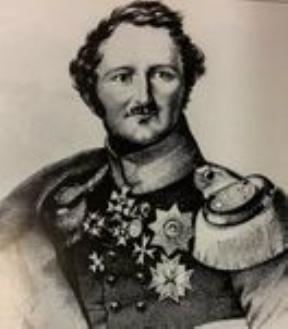
After the war he retired from the army and visited England, where he remained about a year, visiting Her Majesty's Theatre, Haymarket and Drury Lane (admiring Eliza O'Neill), studying parks (he visited the Ladies of Llangollen) and high society, being himself a member of it. In 1822, in compensation for certain privileges which he resigned, he was raised to the rank of "Fürst" by King Frederick William III of Prussia. In 1817 he had married the Dowager Countess Lucie von Pappenheim, née von Hardenberg, daughter of Prussian statesman Prince Karl August von Hardenberg; the marriage was legally dissolved after nine years, in 1826, though the parties did not separate and remained on amicable terms.
He returned to England in 1828 where he became something of a celebrity in London society spending nearly two years in search of a wealthy second wife capable of funding his ambitious gardening schemes. In 1828 his tours took him to Ireland, notably to the seat of Daniel O'Connell in Kerry. On his return home he published a not entirely frank account of his time in England. The book was an enormous success in Germany, and also caused a great stir when it appeared in English as Tour of a German Prince (1831–32).

Being a daring character, he subsequently traveled in Algeria, Tunisia, Egypt and Sudan and explored ancient Nubia. He is documented as having visiting the site of Naqa in modern-day Sudan in 1837. He also visited the nearby site of Musawwarat es-Sufra, and in both places he carved his name in the stone of the temples. In the same year, at the slave market of Cairo he was enchanted by an Ethopian girl in her early teens whom he promptly bought and named Mahbuba ("the beloved"). Together they continued a romantic voyage in Asia Minor and Greece. In Vienna he introduced Mahbuba to European high society, but the girl developed tuberculosis and died in Muskau in 1840. Later he would write that she was "the being I loved most of all the world."
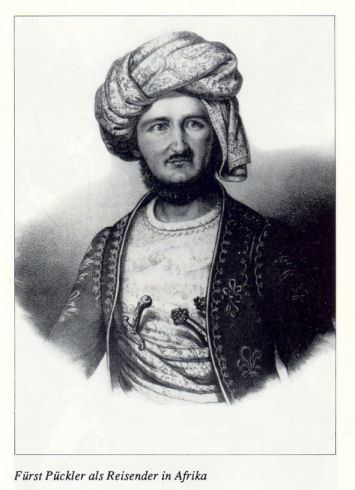
He then lived at Berlin and Muskau, where he spent much time in cultivating and improving the still existing Muskau Park. In 1845 he sold this estate, and, although he afterwards lived from time to time at various places in Germany and Italy, his principal residence became Schloss Branitz near Cottbus, where he laid out another splendid park.
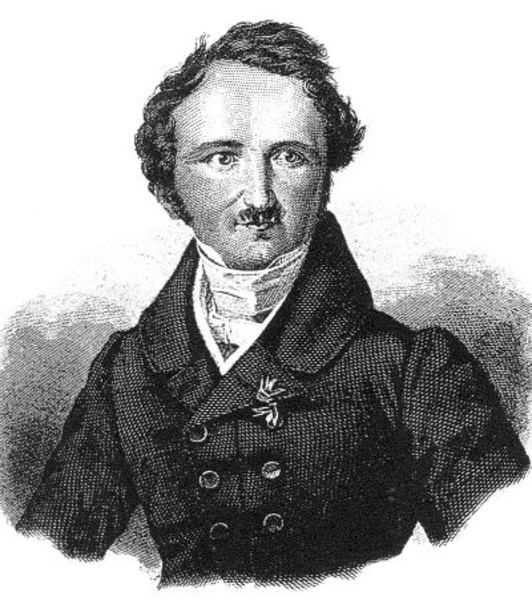
Politically he was a liberal, supporting the Prussian reforms of Freiherr vom Stein. This, together with his pantheism and his extravagant lifestyle, made him slightly suspect in the society of the Biedermeier period.
In 1863 he was made a hereditary member of the Prussian House of Lords, and in 1866 he attended — by then an octogenarian — the Prussian general staff in the Austro-Prussian War. He was awarded for his 'actions' at the Battle of Königgratz, even though the then 80-year old Prince had slept throughout the day. In 1871 he died at Branitz. Since a cremation of the deceased was forbidden at that time for religious reasons, he resorted to a provocative trick, and ordered that his heart be dissolved in sulfuric acid, and that his body should be embedded in caustic soda, caustic potash, and caustic lime. Thus, on February 9, 1871, his remains were buried in the Tumulus - a lake pyramid in the park lake of the Branitzer Castle Park. Since he was childless, the castle and the park fell after his death to his successor to the Majorats, his nephew Heinrich von Pueckler, and all cash and the inventory to his niece Marie von Pachelbl-Gehag, née von Seydewitz. The literary estate of the prince was inherited by writer Ludmilla Assing, who wrote the biography of the author and published his unpublished correspondence and diaries.
The artist
As a landscape gardener, he is considered to be an outstanding artist on a European level.
As a writer of books of travel he holds a high position, his powers of observation being keen and his style lucid, animated and witty. This is most evident in his first work Briefe eines Verstorbenen (4 vols, 1830–1831), in which he expresses many independent judgments about England and other countries he visited in the late 1820s and about prominent people he met. Among his later books of travel are Semilassos vorletzter Weltgang (3 vols, 1835), Semilasso in Afrika (5 vols, 1836), Aus Mehemed Ali's Reich (3 vols, 1844) and Die Rückkehr (3 vols, 1846–1848). He is also the author of the still famous Andeutungen über Landschaftsgärtnerei (1834, "Remarks on landscape gardening"), the only book he published under his own name.
In 2016, the Bundeskunsthalle in Bonn dedicated an exhibition to the excentric Prince , with the title "Die Gartenlandschaften des Fürsten Pückler". Two of his gardens are listed on the UNESCO Lists of World Heritage Sites: one is located in Bad Muskau, the other in Babelsberg near Potsdam. Both are considered to be highlights of the landscape architecture of the 19th century.
There are also drawings and caricatures by his hand, but he did not publish them.
Publications
Fürst-Pückler-Eis
His name is still remembered in German cookery through a sweet called Fürst-Pückler-Eis (Prince Pückler ice-cream), very similar to Neapolitan ice cream - not invented by him, but named in his honour by the Royal Prussian court cook Louis Ferdinand Jungius in 1839.
Fürst Pückler is also mentioned at the conclusion of the novel 2666 by Roberto Bolaño in reference to the dessert bearing his name, in this case, Neapolitan ice cream. He becomes an example of one's reputation being defined unexpectedly by accomplishments of lesser significance.
